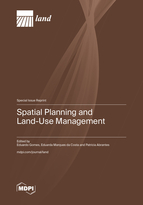Spatial Planning and Land-Use Management
A special issue of Land (ISSN 2073-445X).
Deadline for manuscript submissions: closed (31 July 2023) | Viewed by 30087
Special Issue Editors
Interests: geographic information system; land-use science; collaborative simulation; spatial planning; complexity science
Special Issues, Collections and Topics in MDPI journals
Interests: spatial planning; regional and urban planning; evaluation of public policies; data collection and monitoring systems; health cities
Special Issues, Collections and Topics in MDPI journals
Interests: spatial planning; planning systems; food planning; geographic information systems
Special Issues, Collections and Topics in MDPI journals
Special Issue Information
Dear Colleagues,
Socioeconomic, demographic, climatic, cultural or political drivers have been recognized as major forces shaping the landscape around the world, affecting both the natural and physical structure of the landscape. The competition for land use has led to a continuous loss of natural and semi-natural land to impervious surfaces, contributing to the increase in land fragmentation, the loss of biodiversity and wildlife habitats, and land degradation.
Spatial planning and land-use management instruments play an important role in managing the trade-offs between improving the quality of life of populations and addressing the protection of the environment and natural resource management. Furthermore, they contribute to recognizing alternatives for land use to meet socioeconomic, cultural and environmental demands and ensure the protection of populations, addressing the principles of efficiency, equity and sustainability. However, it is in an “unstable equilibrium” driven by the physical structures of places and how they interact, by the articulation between the different policies and by the socioeconomic agent’s behavior. As spatial planning and land-use management instruments have long-term impacts that will affect the future development of societies, it is critical to develop optimal spatial planning systems and instruments today. This is even more critical in regions where the demand for housing, infrastructures, services or food is expected to grow fast. Some of the measures that could be implemented could be redirected to a more inclusive and system-oriented territorial development (e.g., by adapting the instruments to the different interests of socioeconomic actors while establishing good resource management and a low-carbon future).
Therefore, an improvement in spatial planning and land-use management (by reversing or anticipating potential negative impacts on land-use changes) is critical and can contribute to supporting policymakers in a better decision-making process. In this Special Issue, we would like to invite you to submit regular research articles and reviews articles on one or more of the following topics of interest (but you are not limited to these):
- Spatial planning, land-use management, and decision making to contribute to, for example, the Sustainable Development Goals 2030, The United Nations Decade on Ecosystem Restoration (2021-2030), and the Paris Climate Agreement: green infrastructure, urban health, coastal pressures, periurban systems, and rural–urban interactions.
- Past and/or future land-use/land-cover change analysis and modeling (using, for example, geocomputation methods).
- Participatory land-use planning (using methods and tools to support multi-stakeholder planning approaches) and systemic thinking.
- Land-use impact analysis and future scenario building.
- Land-use conflicts in future scenarios (e.g., new roles for periurban and rurban territories; increasing water consumption in a context of local agricultural systems).
- Land-use and circular-economy planning options.
- Land-use changes and accessibility patterns.
Dr. Eduardo Gomes
Dr. Eduarda Marques da Costa
Dr. Patrícia Abrantes
Guest Editors
Manuscript Submission Information
Manuscripts should be submitted online at www.mdpi.com by registering and logging in to this website. Once you are registered, click here to go to the submission form. Manuscripts can be submitted until the deadline. All submissions that pass pre-check are peer-reviewed. Accepted papers will be published continuously in the journal (as soon as accepted) and will be listed together on the special issue website. Research articles, review articles as well as short communications are invited. For planned papers, a title and short abstract (about 100 words) can be sent to the Editorial Office for announcement on this website.
Submitted manuscripts should not have been published previously, nor be under consideration for publication elsewhere (except conference proceedings papers). All manuscripts are thoroughly refereed through a single-blind peer-review process. A guide for authors and other relevant information for submission of manuscripts is available on the Instructions for Authors page. Land is an international peer-reviewed open access monthly journal published by MDPI.
Please visit the Instructions for Authors page before submitting a manuscript. The Article Processing Charge (APC) for publication in this open access journal is 2600 CHF (Swiss Francs). Submitted papers should be well formatted and use good English. Authors may use MDPI's English editing service prior to publication or during author revisions.
Keywords
- Spatial planning
- Land-use management
- Land-use/land cover
- Participatory planning
- System thinking planning
- Future scenarios
- Land-use conflicts
- Accessibility
- Periurban and rurban territories
- Sustainable development goals
- Geospatial modeling
- Remote sensing
Related Special Issue
- Spatial Planning and Land-Use Management II in Land (1 article)








